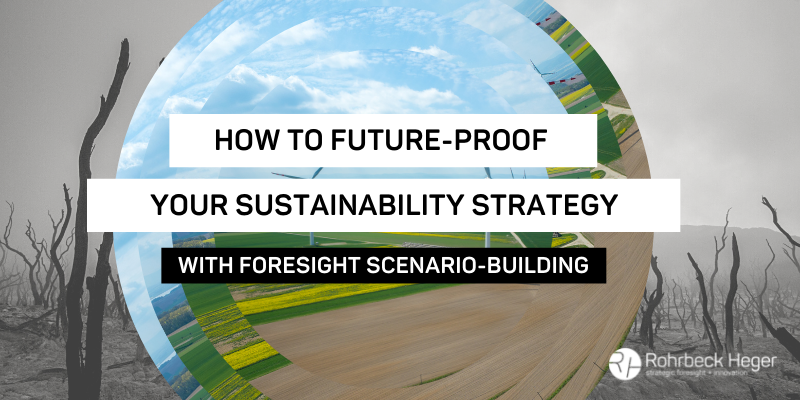
Building a sustainability strategy? Future-proof it with these four scenarios.
The future may be uncertain, but your strategy needn’t be. Strategic Foresight teaches us that when you envision different future outcomes, your strategy is more robust.
by Sebastian Knab, Rohrbeck Heger with Emily Phillips
So, you’re working on your strategy and sustainability is supposed to play a major role. If you’re not sure where to start, you’re not alone. One way to begin is by envisioning possible futures by means of scenario-building. Here we’ll introduce our methodology for scenario-building and present four sustainability scenarios we’ve developed and used in several workshops. This will give you a jumping-off point and help to kick-start your process, so you can build a robust and resilient sustainability strategy that will support you in reaching your business objectives.
It seems as if “sustainability” is on everyone’s mind, especially when it comes to avoiding climate catastrophe. Scientific consensus from the past decades is coming home to roost, what with an unending litany of fires, drought, flooding, and storms filling the headlines. From boardrooms to breakrooms, the sense of urgency is growing: we have to do something.
From boardrooms to breakrooms, the sense of urgency is growing: we have to do something.
While topics such as achieving net-zero CO2 emissions and preserving biodiversity were once the purview of dedicated experts, these questions are now front of mind for those tasked with leading innovation initiatives and business strategy. And with good reason: we find ourselves at what feels like a tipping point. Pressure is mounting: new regulations such as the EU Green Deal are on the horizon while existing commitments such as the Paris Agreement will soon come into effect.
In addition to pressure from governing bodies, many in the private sector are eager to convert their goodwill and desire for a sustainable, healthy future into actual practice, but are uncertain as to how best to approach the enormous task at hand. What could a sustainability strategy look like in practice? And how should it be developed?
What could a sustainability strategy look like in practice? And how should it be developed?
We’re in the business of managing uncertainty
One of the more challenging aspects of first forming and then applying a sustainability strategy is its inherent uncertainty: what will the future hold, and how can we do our best to ensure that we’ll not only survive but thrive in it? Well, we’ve got both good news and bad: the bad news is that no one really knows what the future will hold. But the good news is it is possible to implement a deliberate, systematic, and rigorous assessment of possible futures, assess their likelihood, and then identify the risks and opportunities inherent in each of the possible outcomes.
It is possible to implement a deliberate, systematic, and rigorous assessment of possible futures, assess their likelihood, and then identify risks and opportunities inherent in each.
At Rohrbeck Heger, one of the many exercises we conduct with our clients in this process is scenario-building. The process starts by exploring key drivers of change, including technological and regulatory trends, customer preferences, and stakeholder/ecosystem behavior. The next step seeks to understand the different ways each change driver’s behavior could unfold, ultimately crafting (a) comprehensive, coherent picture(s) of the future.
Whereas traditional strategy development treats uncertainty in a sensitivity analysis at best, we put it where it belongs: center stage. Working with scenarios requires that you acknowledge uncertainty and work constructively with it. By building different futures, you’re able to better prepare for what actually comes. You can identify safe bets and calculated risks, develop contingency plans, and become adaptive and agile if things unfold differently than expected – in short, build up strategic resilience.
Whereas traditional strategy development treats uncertainty in a sensitivity analysis at best, we put it where it belongs: center stage. Working with scenarios requires that you acknowledge uncertainty and work constructively with it, building strategic resilience.
A sustainable future? Presenting our four scenarios
At our recent Future Atelier on Sustainability in the Supply Chain and Logistics industry, we plotted four possible scenarios for the world in 2030, represented in quadrants. When selecting the variables represented by the axes, we sought out two that we assume would have the biggest impact on the future of sustainability, but also – and this is an essential point – these variables are in themselves highly uncertain. Each quadrant in the image below represents a possible combination of the impactful and uncertain variables we selected:
- The x-axis – Environmental regulations: Would governments come together to effectively enforce binding and comprehensive regulations to regulate carbon emissions?
- The y-axis – Sustainable behavior: How sustainable would the collective behavior of individuals and organizations be?
Here’s what that looked like:
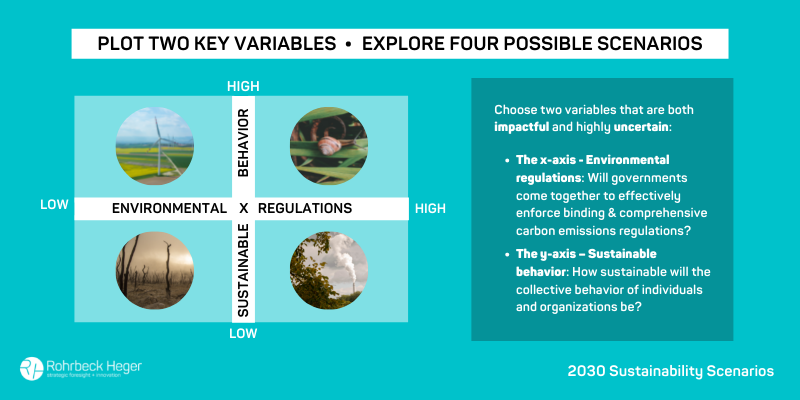
In the following text, we dig deeper into these four quadrants, illustrating four visions of what the world might look like in 2030. While some of these scenarios might seem more likely than others, this exercise asks you to consider all four possibilities. We’ve put these scenarios to use clients and event participants from various companies; this exercise is ultimately industry agnostic and relevant to anyone building a strategy, no matter your business. While the specifics of how a scenario might play out in banking vs. healthcare will vary, the overarching “imagined world” acts as a constant.
Without any further ado, here are our four sustainability scenarios:
While some of these scenarios might seem more likely than others, this exercise asks you to consider all four possibilities.
Scenario 1: “Self-healing” – Making the Green Economy Work
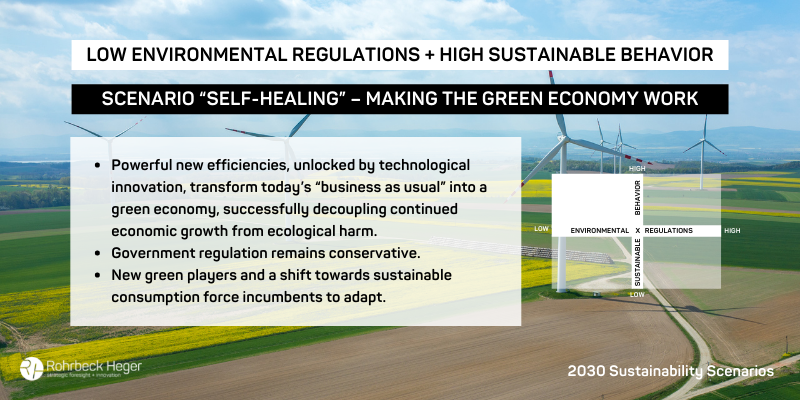
Waking up and pulling back the blinds, the early morning sun heralds yet another scorching summer day. Above your head, the solar panels that cover the roof have been hard at work for a few hours already, generating the energy that powers your home. Checking your phone for the morning’s news, the headlines are abuzz with the latest long-awaited report from the IPCC: “2 DEGREES AVERTED” they read – a glimmer of hope after the dramatic coastal flooding, prolonged droughts, and month-long wildfires of these last 10 years.
Sleepily you make your way through the house and check on the 3D printer’s latest work before the kids get to it first: a sheet of model airplane pieces for them to painstakingly assemble, printed with the same polymer that once built their stackable baby rings, then LEGOs, and now, magically transformed overnight into a new pastime. Your voice assistant chirps and reminds you that the electrically-powered autonomous delivery vehicle made its drop-off 15 minutes ago – there are groceries waiting by the door. Thanks to new local greenhouses, fresh produce is grown within a 25km radius, and available even in winter. You open the door, and the day begins.
In this scenario, which we’ve christened “Self-Healing,” technological progress will enable solutions that manage to successfully decouple continued economic growth from ecological harm. Consumers, fearful of ecological collapse and determined to contribute to a solution, undergo a strong shift in mindset and change their purchasing behavior in favor of sustainable consumption, forcing companies to adapt. Government regulation remains conservative, but thanks to breakthroughs in cleantech, companies embrace green technologies and can keep the growth paradigm in place while still achieving net-zero CO2 emissions. Not to be underestimated is the pressure from new green players, whose entrance into the market and leveraging of technological innovations puts the onus on incumbents to react or collaborate.
This possible future, where individual choice and market solutions manage to halt the planet’s warming in its tracks, posits that powerful new efficiencies, unlocked by technological innovation, would transform today’s “business as usual” into a green economy, securing continued economic growth and avoiding ecological catastrophe, and this all within enough time. The “Self-Healing” scenario assumes that ethical business practices and individual consumer choices would ensure a verdant, affluent future, successfully “liberating the environment from the economy.”
This vision of green growth is one we’re well familiar with and many of us hope for, a narrative and goal that has been adopted by corporate entities and government leaders alike. But what if it’s simply a pipe dream, so-called “greenwishing”? Let’s take a look at another possible future, “Deliberate Slow-Down.”
Scenario 2: “Deliberate Slow-Down” – Shifting to Post-Growth
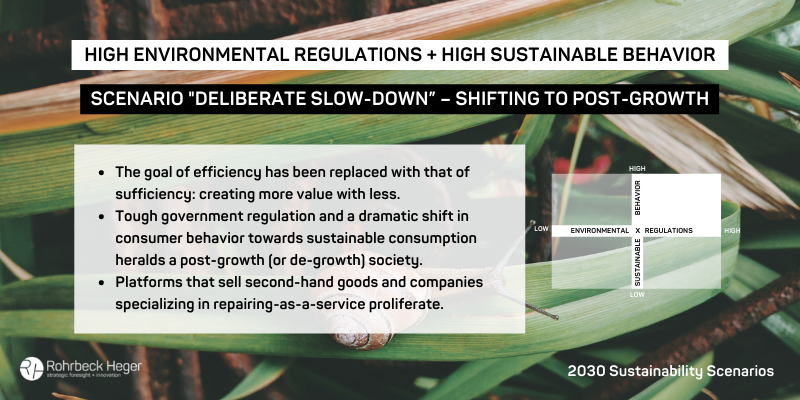
It’s shortly before 8am: time to get to work and send the kids off to school. With backpacks, lunch sacks, and helmets you hustle out the door and squeeze the youngest into their now too-small bike seat, making a mental note to post an advert for it on the local kids’ equipment digital sharing marketplace.
As you cycle to the school bus stop, you reflect on the changed world your children will inherit. After dire scientific predictions about rising temperatures and sea levels started coming true in the early 2020s, worldwide governments stepped up and set binding, comprehensive regulations in order to reduce CO2 emissions and avert climate catastrophe and ecological ruin.
A decade later, a new way of life has firmly taken root and begun to blossom. What was known earlier as “the sharing economy” is simply the economy now, with renting and repairing taking the place of ownership and thoughtless disposal. And there are plenty of jobs, especially in care work: healthcare, minding children, and supporting the elderly, not to mention the boom in public infrastructure. The upkeep of public transportation systems, retrofitting buildings for energy efficiency, and maintaining renewable energy sources require many helping hands.
You blow kisses to the kids as the electrically powered bus takes them to school and you head onwards to the park and ride station. Locking your bike next to the carsharing parking lot, the train shuttles you and other commuters into the city to start your workday.
In this scenario, the gospel of efficiency has been replaced with that of sufficiency: creating more value with less in what can be called a post-growth society. Dreams for achieving so-called “green growth” were simply that – dreams – and it was thanks to rigorous regulation, combined with consumers’ sustainable behavior, that managed to stabilize global temperatures and avoid the grim projections that shook the world awake just a decade ago.
When tough regulations came into effect, they were based in part on a new consensus that given climate change’s imminent threat and wily, accelerating timeline, a decoupling of continued economic growth and maintenance of a habitable world were simply at odds with one another, largely due to insurmountable rebound effects. As a result, things are slower, now, but the air is cleaner and a precipitous drop in biodiversity, rising sea levels, and full thawing of the arctic tundra were averted.
By the early 2020s, the world was simply reaching the limits of growth, just as the famed 1972 paper posited, and in 2030 “a period of great transition: from growth to equilibrium” is well underway. For example, global shipping now relies on wind-powered sails in favor of air freight. Platforms that sell second-hand goods and companies specializing in repairing-as-a-service proliferate. In addition, “servitization” – replacing products such as cars with services such as mobility – is the name of the game in many industries.
A global post-growth economic restructuring sounds too far-fetched? How about a scenario that many of us can imagine, and some would say we’re currently experiencing: good intentions that simply don’t do enough to mitigate destructive change.
Scenario 3: “Boiling the frog“ – just not getting there
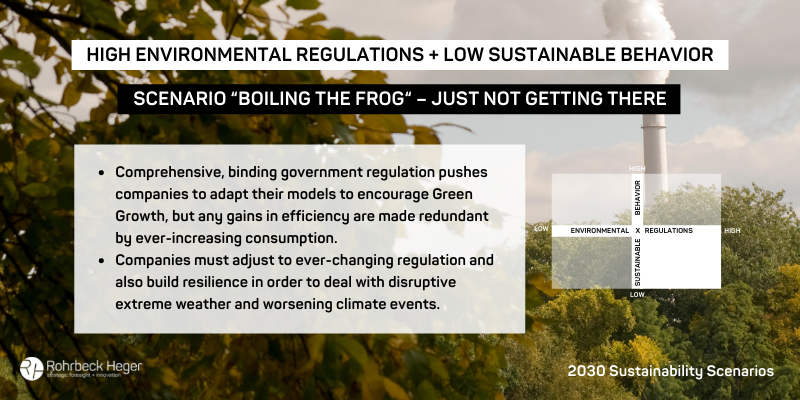
Snagging a coveted seat for your train commute, your eye catches a clever new advert from a fast-fashion retailer as the train pulls away from the platform. The new limited edition eco collaboration is with one of your favorite designers; maybe you’ll find 20 minutes at lunch to pop by the shop around the corner from your office building and get a piece before it sells out.
Leaving the center city station, you nearly trip over the latest installment from pro-eco activists, who, dressed in red from head-to-toe, lie motionless, covering the vast plaza beyond the revolving doors. Some passers-by hurl insults at those lying on the ground, accusing them of naïveté and rabble-rousing; after all, the government has recently issued yet another new measure to curb CO2 levels after the latest mass exodus of climate refugees from coastal cities.
Later, taking the elevator up to your floor, you check the day’s calendar: as a Senior Analyst for Climate Change Adaptation, you’ve got a day full of meetings with your team as you prepare an upcoming workshop for the Global Supply Chain Director from a major international coffee brand. With severe droughts in 30% of their grower regions, plus the new pressure to comply with resolutions from the COP26 Glasgow Summit now coming into effect, they have their hands full as they struggle to secure the supply chain and keep the world caffeinated. Which reminds you as the elevator doors slide open: time for your second cup.
In this scenario, comprehensive, binding regulation on the part of international government agreements pushes companies to adapt their models to encourage Green Growth, but this is not matched by corresponding sustainable behavior on the part of people and other organizations. While steps to mitigate climate change have been taken (and good intentions reign among many), humans are the proverbial clueless amphibians, and the Earth is a great big pot, getting hotter and hotter as it starts to boil.
As climate regulations become increasingly strict, any gains in efficiency are made redundant by ever-increasing consumption; strong rebound effects persist even among self-professed green advocates who, unwittingly or not, suffer from an attitude-behavior gap.
In part due to cleantech breakthroughs’ failure to materialize, companies’ foci are split in two: on the one hand, trying to adjust to an ever-evolving regulatory environment, while on the other, building resilience practices so as to weather the increasingly disruptive effects of droughts, floods, fires, and storms.
It couldn’t get much worse than a slow death by boiling, right? Not so fast – there’s one final scenario to explore.
Scenario 4: “Deliberate ignorance” – pushing nature around
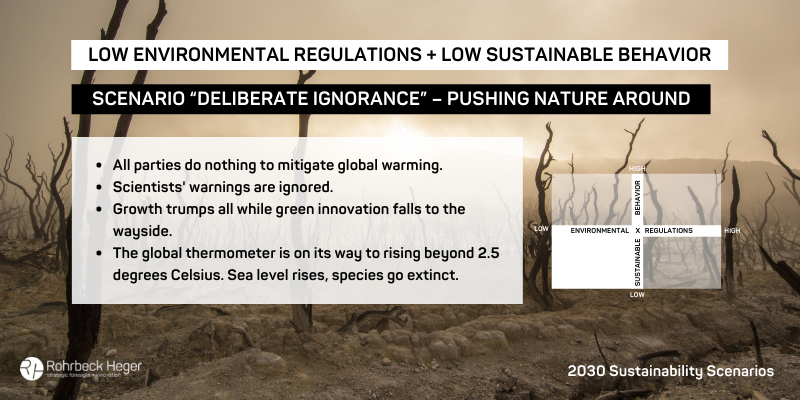
The lights in the office flicker once, and then with a great, heaving whine, the electricity shuts off. A collective sigh and exclamations reverberate among your colleagues. Another blackout, and the last one was only two months ago. At least it’s the end of the workday and you can hitch a ride home to the suburbs.
The thought of an unknown number of days ahead without air conditioning has you worried. Your aging parents have moved in with you and your family since they lost their home in the fires last April. The heat index has been so high that the greater metropolitan area doesn’t manage to cool down at night, and more and more elderly people have been succumbing to heat stroke and other complications. “I’ll set an alarm to check on them during the night,” you think, reassuring yourself. Gathering your equipment and hoisting your bag onto your shoulder, you change into your tennis shoes: no electricity means no elevator, and no elevator requires a climb down 43 flights of stairs. It’s a drill that’s become more and more familiar in recent years, ever since the local power grids started to collapse in the sustained heat of summer.
Later, you and your colleague sit in bumper-to-bumper traffic, trying to get on the interstate in fits of stops and starts. You listen half-heartedly to their account of trying to get their hands on some real vanilla to make a favorite recipe for their partner’s birthday. “Hothouse strawberries could be delivered by drone, no problem,” they explain. But because of deforestation and continued droughts in Madagascar, 80% of the world’s vanilla supply has simply disappeared, making it nearly impossible to get your hands on the real deal. “It’s the least of our problems,” you think to yourself, as you lean back and close your eyes, trying to enjoy these last moments of air-conditioned cool.
This scenario assumes that all parties do nothing to mitigate global warming, and sustainability efforts on the part of governments, individuals, companies, and other actors fall entirely to the wayside. Scientists’ warnings are ignored and even lampooned as the post-factual era takes root. Growth has trumped all: unregulated economic growth and an inverse trend in game-changing green innovation breakthroughs herald a global thermometer that’s rising with no sign of stopping: the world is well on its way to warming more than 2.5 degrees Celsius. The ecological effects and their fallout are beginning to snowball: seawater rises higher, and the list of extinct species grows longer. In short: it’s an age of disruption that we can only begin to imagine but one that should not surprise us, as one catastrophe follows another.
A note on scenarios
Scenarios are meant to provoke; after all, they’re what you get when you cross two variables at their respective extremes. There may be aspects of all four scenarios that sound familiar, or even very plausible. On the flip side, some of what we’ve described may seem highly unlikely, or even preposterous. So why bother with scenarios at all? For one very simple reason: so that you and your team can align on your vision of possible futures, a prerequisite for positioning and preparing your company for success in those imagined spaces.
Why bother with scenarios at all? For one simple reason: so that you and your team can align on your vision of possible futures, a prerequisite for positioning and preparing your company for success in those imagined spaces.
Assessing the four scenarios: how likely are they?
More often than not, when we do this exercise and facilitate scenario-building, teams will be split in their assessment of the likelihood of one scenario over another, and even disagree on their company’s or industry’s preparedness should any of them occur. Oftentimes, teams will even realize that they are more prepared for a scenario which they deem less likely to happen! Scenario building and assessment, then, helps a team to explore different possibilities, support strategic discussion, and ultimately work together to align on a shared vision of the future. This shared vision supports their common goal to prepare their business strategy and stress test their innovation roadmaps in order to find out if they’re robust enough to weather different outcomes.
During our Future Atelier workshop that examined these scenarios within the context of the logistics and supply chain sectors, we asked participating industry experts this very question: which is the most likely scenario?
Here’s the results:
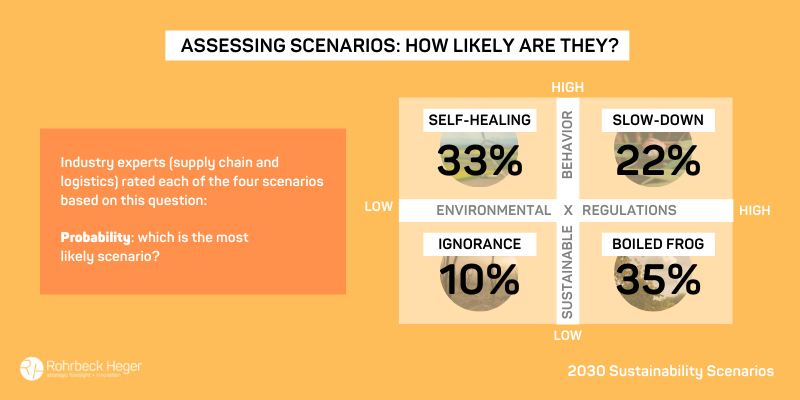
Rated as most likely to occur we find scenario three, “Boiling the Frog,” which, in some respects, best represents “real life” in 2021. We can observe this scenario at play, today. Thus, we can rate it as fairly probable and claim that we’re somewhat prepared for it. Might this, however, lead to a bias in its likelihood rating? It may feel “comforting” (if being boiled slowly could ever be described as such), but we must remember that the future won’t necessarily look anything like the present. It can do us good to “think outside the box” and prepare for other future scenarios that look very little like what we know.
We must remember that the future won’t necessarily look anything like the present. It can do us good to “think outside the box” and prepare for other future scenarios.
In second place comes Scenario 1: “Self-healing.” This scenario describes what many of us not only hope for, but expect to and believe will happen: “We’ll develop powerful, green tech and everything will be fine!” This scenario sells us the story that we can solve all of our problems while still remaining in our current thinking, never challenging the predominant paradigms. It’s no surprise, then, that it’s been rated as highly probable. But might there be dangers in betting on this and only this at our moment in time?
Interestingly, Scenario 2: “Deliberate slow-down” has a relatively high rating – certainly curious when you consider that overall, very few people in the private sector actually expect this to happen, don’t want this at all, nor can they really imagine how this could possibly work in practice. Could it be that the probability score is too high, reflecting a lack of understanding on the part of those who rated it? Some experts make the case that de-growth and post-growth may be the only way to actually meet the ambitious climate targets that will prevent ecological collapse. It might be worth it for businesses to consider this possibility.
The scenario with the lowest environmental regulation and lowest sustainable behavior, “Deliberate Ignorance,” was a clear “loser” according to the ratings. Comforting perhaps, yet consider this: airlines already have contingency plans for more extreme weather conditions. Agriculture must brace for less predictable rainfall. Coffee and chocolate producers are being forced to consider a world where deforestation and extreme weather threaten their supply chain.
While many would rate this scenario as least likely to occur (especially considering its extremity), we are living in a VUCA world, and uncertainty is high. It’s perhaps prudent to consider different rolls of the dice when preparing a strategic sustainability transformation. And while most businesses would dismiss this scenario as “backwards thinking” – no one is seriously debating whether change must happen – there are other voices who say that we’re not doing enough and that we must prepare for dire global warming consequences. At any rate, we will find ourselves unable to avoid these challenges in their entirety.
While many would rate this scenario as least likely to occur, we are living in a VUCA world, and uncertainty is high. It’s perhaps prudent to consider different rolls of the dice when preparing a strategic sustainability transformation.
A call to prepare for (a) brave new world(s)
As we’ve written before, “crisis is not a cause for despair but a trigger point to make way for thoroughly new ways of operating and envisioning success.” The COVID-19 pandemic has highlighted humanity’s adaptability to difficult circumstances as well as its ability to work together, facing down a global challenge. The 2020s will be the defining decade for addressing climate change, with surging storms and raging fires only making us sense the high stakes more acutely. What we’ve done until now hasn’t been enough. Consider the fact that the private sector’s increased measuring and reporting has not translated into lower CO2 emissions, but instead coincides with the exact opposite: “It turns out that reporting is not a proxy for progress,” reported Harvard Business Review.
Given the increasing pressure from nature and resulting pressure from societies and regulators, sustainability has arrived center stage in every strategic discussion. However, the only certain thing about the future of sustainability seems to be its uncertainty. How are regulators going to take on the challenge of pushing for sustainable development? How are consumers going to adapt their consumption patterns towards sustainable lifestyles? Is technological progress enough to decouple economic growth from environmental degradation? Strategic foresight teaches us not to hone in on easy answers to these questions, but instead to explore possible future scenarios, prepare for alternative paths, and build a resilient strategy to win the future.
Emily Phillips contributed research and writing.
